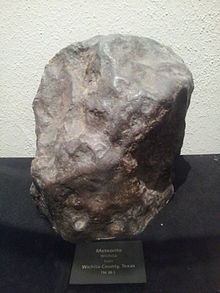Texas Science And Natural History Museum
The museum won "Best of Austin" awards from the Austin Chronicle in 2002, 2005, and 2012.
The museum had exhibits on Texas history, anthropology, geography, and ethnography, but these were relocated to other museums (including the Bullock Texas State History Museum) in 2001. In October 2013, Linda Hicke, the dean of Austin's College of Natural Sciences, cut the museum's funding by $400,000.
The museum closed in 2022 for extensive renovations. It underwent a re-branding and became Texas Science & Natural History Museum. The museum reopened on September 23, 2023.
Wichita County Meteorite

In 1723, the Comanche defeated the Lipan Apache people in a nine-day battle along the Rio del Fierro (Wichita River). The River of Iron may be the location written about by Athanase De Mezieres in 1772, containing "a mass of metal which the Indians say is hard, thick, heavy, and composed of iron", which they "venerate...as an extraordinary manifestation of nature", the Comanche's calling it "Ta-pic-ta-carre [standing rock], Po-i-wisht-carre [standing metal], or Po-a-cat-le-pi-le-carre [medicine rock]", the general area containing a "large number of meteoric masses".
"According to the Indians, the mass was first discovered by the Spaniards, who made several ineffectual attempts to remove it on pack mules but were finally compelled to abandon it on account of its great weight. The Comanches at first endeavored to melt the mass by building large fires around it, but failing in this, they next attempted to break it in pieces, in which they were likewise unsuccessful; they then conceived the idea that it was a wonderful medicine stone and therefore worthy of their most profound regard...it was the custom of all who passed by to deposit upon it beads, arrowheads, tobacco, and other articles as offerings."
The Wichita County meteorite originally weighed 145 kg and was obtained by Major Robert Neighbors, US Indian agent at Fort Belknap, in 1858-1859, who presented it to the State Cabinet, and was displayed in the old Capitol building before it burned down, when this Coarse Octahedrite was turned over to the University of Texas. According to Neighbors, "When the meteorite was conveyed to the Indian reserve, the Comanches collected in great numbers around their valued medicine stone and, whilst manifesting their attachment by rubbing their arms, hands, and chests over it, earnestly besought Major Neighbors to permit them to keep it at the agency."
A sister meteorite weighing 742 kg, the Red River meteorite, was discovered in 1808 but this Medium Octahedrite now resides in the Yale Peabody Museum of Natural History.

References
- ^ TeamWeb (May 2001). "UT Austin - VRC - Highlights". UT Austin. Archived from the original on February 14, 2005.
- ^ "Awards Received". Texas Memorial Museum. The University of Texas at Austin. Archived from the original on April 13, 2015.
- ^ Green, Anthony (October 29, 2013). "On-campus museum set to lose $400,000 in funding". The Daily Texan. Archived from the original on July 24, 2018. Retrieved July 23, 2018.
- ^ Seale, Avrel (September 20, 2023). "An Evolving Texas Memorial Museum Opens Again". UT News. Retrieved September 24, 2023.
- ^ "History of the Museum". The University of Texas at Austin. Retrieved September 21, 2023.
- ^ Dunn, W. E., 1911, Apache Relations in Texas, 1718-1750, in the Texas Historical Association Quarterly, Vol. 14, No. 3, p. 220
- ^ Bolton 1914, pp. 24–25.
- ^ Bolton 1914, p. 296.
- ^ Farrington 1909, p. 486.
- ^ Neighbors, K.F., 1975, Robert Neighbors and the Texas Frontier, 1836-1859, Waco: Texian Press, p. 65 and 172
- ^ Farrington 1909, p. 487.
- ^ Farrington 1909, p. 488.
Bibliography
- Bolton, H. E. (1914). Athanase de Menzieres and the Louisiana-Texas Frontier, 1768-1780. Vol. 1. Cleveland: The Arthur H. Clark Company.
- Farrington, Oliver C. (1909). Meteorites of North America, to January 1, 1909. Vol. XIII. National Academy of Sciences. OCLC 1315050608.
